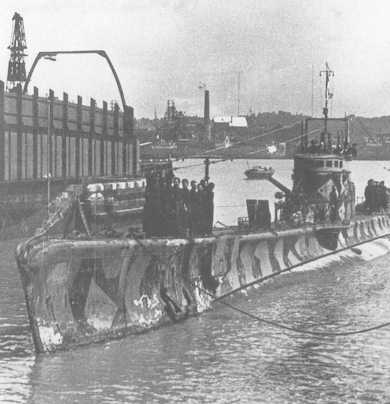|
The odyssey of the R.Msg Perla
 On July 9th, 1942 the Perla was intercepted off the port of Beirut by the British corvette HMS Hyacinth. Seriously damaged by depth charges, the boat was forced to the surface and fell into enemy hands. Towed to the Lebanese port, the Perla was repaired and renamed P-712 by the British Navy. In 1943 she was transferred to the Hellenic Navy, renamed Matrozos, where she served until 1947. On July 9th, 1942 the Perla was intercepted off the port of Beirut by the British corvette HMS Hyacinth. Seriously damaged by depth charges, the boat was forced to the surface and fell into enemy hands. Towed to the Lebanese port, the Perla was repaired and renamed P-712 by the British Navy. In 1943 she was transferred to the Hellenic Navy, renamed Matrozos, where she served until 1947.
On September 27, 1941 HMS Hyacinth sunk Italian U-boat Fisalia.
Specifications, R.Msg Perla, Perla class:
ThePerlawas a submarine of medium displacement belonging to the so-called `600` class. The boat was considered a successful submarine under an engineering viewpoint. Designed for short cruise, launched on May 1, 1936, commissioned in 1937, she was first of 10 units of her class.
Displacement (srf/sub tons): 695/855
Dimensions (L*B*D meter): 61.18*6.45*4.7
Propulsion: 2*700hp diesel engine, 2*400hp electric motors,2 shafts
Speed (srf/sub knots): 14/7.5
Range (srf/sub n/miles@knots): 5,200@8/72@4
Diving depth (meter): un known
Complement: 44 officers and enlisted
Torpedo: 6*21" (533mm) bow torpedo tubes, total of 12 torpedoes
Mines: none
Armament: 1*100mm/ 47 main deck gun, 2*13.2mm AA machine gun
The odyssey of the R.Msg Perla
During the second half of February 1941, the Italian naval supreme command decided to transfer the last four submarines still operational in the Red Sea from the base in Massaua, Eritrea to Bordeaux, France. This decision was fully supported by Duke Amedeo D’Aosta, supreme commander of the Italian forces in East Africa and by the local naval command, and it was made when the military fate of the Italian empire began to worsen without any possibility of recovery.
Based on these considerations, it was decided to allow the surface and submarine units to attempt to run away and reach friendly or neutral ports. The submarine Perla, under the commandof Captain Bruno Napp, an officer from Trieste, was ordered to set sail and reach the German-occupied French coast.
The Perla departed from Massaua on March 1st, 1941 under strict orders not to engage any enemy unit during the transfer. For the records, this was the first time that a submarine of the “600” class was attempting such an endeavor, considered difficult even for boats with much larger hulls. Nevertheless, due to the quality of the hull and the engines (repaired as best as possible after the unit had run aground) and the extraordinary seamanship of Captain Napp and his crew of 38 well-trained sailors, who had never experienced such a long journey before. The Perla covered 13,100 n/miles in 81 days, facing rough seas, technical problems, and enemies, establishing a record for the class.
After being twice refueled and supplied, at sea, by German support vessels, in the late afternoon of the 14th of May, passing Cape Finisterre, the Perla pointed decisively toward the French coast arriving in sight of Bordeaux on the 18th. Escorted by a German vessels, the patched up and smoky (the diesel engines were exhausted) submarine entered the estuary of the Gironde, docking at the submarine docks around 16:00 on May 19th.
Once ashore, Napp and his crew were welcomed by a German and Italian honor guard, and the enthusiasm of the submarine crew present at the base. These were seamen who understood and respected the endeavor just completed by the young men of the Perla.
Back to history Index
 |
Greece |
1947 |
HMS Hyacinth towing the Italian U-Boat Perla |
|